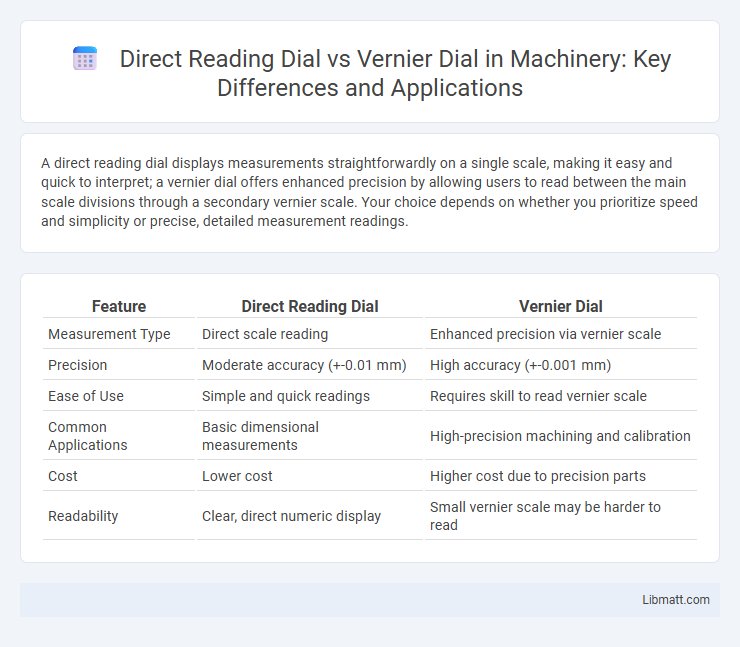A direct reading dial displays measurements straightforwardly on a single scale, making it easy and quick to interpret; a vernier dial offers enhanced precision by allowing users to read between the main scale divisions through a secondary vernier scale. Your choice depends on whether you prioritize speed and simplicity or precise, detailed measurement readings.
Table of Comparison
| Feature | Direct Reading Dial | Vernier Dial |
|---|---|---|
| Measurement Type | Direct scale reading | Enhanced precision via vernier scale |
| Precision | Moderate accuracy (+-0.01 mm) | High accuracy (+-0.001 mm) |
| Ease of Use | Simple and quick readings | Requires skill to read vernier scale |
| Common Applications | Basic dimensional measurements | High-precision machining and calibration |
| Cost | Lower cost | Higher cost due to precision parts |
| Readability | Clear, direct numeric display | Small vernier scale may be harder to read |
Introduction to Direct Reading Dials and Vernier Dials
Direct reading dials display measurements directly on a calibrated scale, allowing for quick and straightforward readings without additional calculations. Vernier dials enhance measurement precision by incorporating a secondary, movable scale that enables users to read values between the smallest gradations on the main dial. These two types of dials are commonly used in precision instruments such as micrometers and calipers, where accuracy and ease of use are critical.
How Direct Reading Dials Work
Direct reading dials work by displaying measurements on a graduated scale that allows users to read values directly without further calculations. The pointer moves proportionally to the input, aligning with numerical markings that represent specific units, ensuring quick and straightforward data interpretation. This design enhances precision and reduces user error compared to vernier dials, which require manual interpolation between scale divisions.
How Vernier Dials Function
Vernier dials function by providing enhanced measurement precision through a secondary scale that slides alongside the main scale, allowing readings to be taken at fractions of the smallest main scale unit. The vernier scale aligns with the main scale to indicate measurements with increased accuracy, commonly used in engineering and machining for fine adjustments. Unlike direct reading dials, which display values on a single graduated dial, vernier dials enable the user to interpret finer increments by comparing the relative positions of the scales.
Key Differences Between Direct Reading and Vernier Dials
Direct reading dials provide measurements through a single pointer and a fixed scale, allowing quick and straightforward readings without requiring interpolation. Vernier dials feature an additional vernier scale that enables users to measure more precise fractional increments by aligning scales visually. The key difference lies in accuracy, with vernier dials offering enhanced resolution for fine measurements compared to the simpler, faster readings of direct reading dials.
Accuracy and Precision Comparison
Direct reading dials provide quick measurements with moderate accuracy, typically suitable for general applications requiring less precision. Vernier dials offer higher precision by allowing measurement readings to be refined to fractions of the smallest scale division, enhancing accuracy significantly. For tasks demanding exact measurements, your choice of a vernier dial ensures superior precision compared to a direct reading dial.
Applications in Industry and Laboratories
Direct reading dials are widely used in industrial machinery setups for quick, straightforward measurements, enabling efficient monitoring of equipment alignment and calibration without the need for complex calculations. Vernier dials find extensive applications in laboratories requiring high precision and fine measurement resolution, such as material testing and scientific experiments where exact dimensional data is critical. Both types enhance accuracy and reliability in their respective environments, with direct reading dials favoring speed and simplicity, and vernier dials excelling in meticulous measurement tasks.
Ease of Use and User Experience
Direct reading dials offer straightforward measurements with clear numerical displays, enhancing ease of use for quick readings. Vernier dials provide higher precision through the alignment of scale markings but require more skill and time to interpret, impacting user experience. Users prioritizing speed favor direct reading dials, while those needing accuracy prefer vernier dials despite the steeper learning curve.
Maintenance and Durability Considerations
Direct reading dials generally require less maintenance due to their simpler design with fewer moving parts, reducing the risk of mechanical wear and calibration drift. Vernier dials, while offering higher precision, demand more frequent calibration and careful handling to maintain accuracy, as their fine adjustment components are more susceptible to damage and misalignment. Durability-wise, direct reading dials tend to withstand rough usage better, making them ideal for environments where robustness is critical.
Cost and Availability
Direct reading dials typically offer a lower cost and greater availability compared to vernier dials due to their simpler design and widespread manufacturing. Vernier dials, while more precise, tend to be more expensive and less commonly stocked, limiting immediate accessibility. Your choice may hinge on budget constraints and the urgency of acquiring the measuring tool.
Choosing the Right Dial for Your Needs
Direct reading dials provide immediate, easy-to-read measurements with a single scale, ideal for quick and straightforward tasks requiring rapid data interpretation. Vernier dials feature an additional vernier scale allowing for higher precision and finer measurement increments, suitable for detailed work demanding exact values. Your choice between these dials should balance the need for speed versus accuracy, based on the specific requirements of your application.
Direct reading dial vs vernier dial Infographic

 libmatt.com
libmatt.com